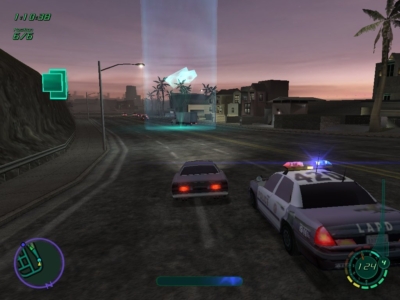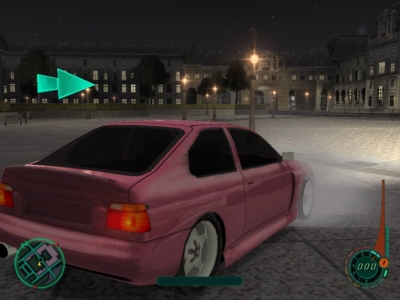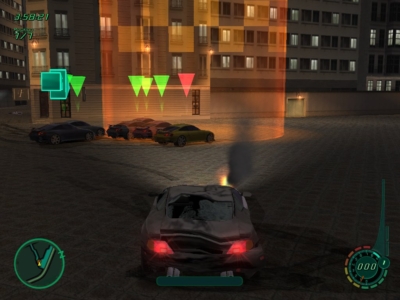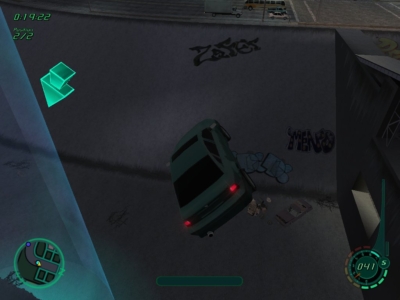
Midnight Club II
Written by: Rik
Date posted: May 31, 2009
- Genre: Racing
- Developed by: Rockstar
- Published by: Rockstar
- Year released: 2003
- Our score: 8
While we’ve been known to pluck out a game at random from the middle of a series – rather than, say, start at the beginning and work our way through in chronological order, which would make much more sense – this, thankfully, isn’t one of those occasions. Yes, there was a game before this one, going by the catchily-predictable name of Midnight Club, but it never got a release on PC, mainly because it was a largely-underwhelming rehash of Midtown Madness that appeared on PlayStation 2 around launch time.
The resemblance between the two games was hardly surprising, given that they were both developed by Angel Studios. The main change was in theme, with Midtown’s relatively wholesome, sunny-day approach to the world of city-based racing being replaced by something a little more ‘street’. By all accounts, though, the changes were fairly superficial, and it could have done with a bit more work, with the game largely failing to impress console critics normally quick to excitement.
By 2003, Angel had become Rockstar San Diego, and we had a sequel deemed worthy of the PC market. Just kidding, console gamers – as if quality control has anything to do with these kinds of decisions – but whatever the reason, it’s a sure bet that the runaway success of enjoyably-stupid street-racing film The Fast and the Furious probably had something to do with it. While pre-Diesel interest in the racing of souped-up Japanese import cars was certainly there, high-profile games based upon it were in short supply, with the likes of Tokyo Xtreme Racer and the original Midnight Club failing to attract much attention. After the film was a hit, EA made it the theme of their next Need for Speed game, NFS: Underground (which sold around 1 billion copies).
Rockstar, though, got there first with this effort, an accomplished game hiding behind a slightly scrappy exterior that could cause you to doubt its ability to deliver where it matters. Early impressions are far from favourable, with the slightly muddy cityscape and generic appearance of the vehicles indicating that there’s very little to be excited about. Indeed, given that the game boasts the Rockstar moniker, it becomes very hard to avoid the suspicion that the whole thing is a low-effort knock-off of the third game in the Grand Theft Auto series (no, we’ve not covered this one, but I figured you might have heard of it anyway).
While there’s room in the gaming universe for a free-for-all crime sim and a tightly focused racer, if the two happen to come from the same stable within 18 months of each other, there’ll always be the suspicion of a lack of endeavour, on the technical side at least. That’s not to say this is a bad looking game, but a little more polish could certainly have distanced it a little more from its more famous cousin and improved first impressions in general.
Visuals aside, dipping your toe into the career mode does little to dispel any doubts you might have about jumping into the, er, Midnight Club pool too enthusiastically, either. After driving around aimlessly for a while in your shitheap car, which looks like a Ford Escort (it isn’t, though – in fact none of the cars are licensed, and all have slightly daft, made-up names while looking vaguely like real-life counterparts), you come across a street racer called Moses, who refers to you as a ‘little shrimp’ (a reference beyond me) and says ‘yo’ a lot (this is a recurring theme throughout the game). After challenging you to a couple of easy races, you end up winning his car, at which point he inexplicably takes a shine to you.
It’s not the most promising of starts, and offers little hint of the fun to come. The story, such as it is, doesn’t get any better, offering little more than a basic framework for the action which starts on the streets of LA before moving on to Paris and then Tokyo (and, later, back and forth a bit). Frankly, there’s not a lot of scope for originality here, and you can pretty much guess the gist of it all: you start off as a know-nothing punk with a terrible car, but with a dream – of becoming the best street-racer in the world. Etc.
Ignoring all that though, the game itself quickly gets into its stride. The template is roughly the same as Midtown Madness: racing a handful of opponents through the city, with traffic, police and the usual obstacles to negotiate – but it’s a formula that’s been honed and fine-tuned so that we’re no longer dealing with a mildly diverting arcade racer, but a compulsive adrenaline-fuelled challenge that will have you hunched over your PC for hours, stopping only to ease joypad-related injuries.
The best way to describe the action is to say that, once you get past the lacklustre opening encounters, a typical race is like being in a car-chase scene from a Hollywood movie. There are bumps, jumps, handbrake turns, crashes and explosions waiting for you each and every time you get out there. As with the movies, some concessions regarding levels of realism have had to be made. So, the cars are insanely fast and handle extremely responsively; damage models are there (one of the benefits of featuring ‘unofficial’ cars) and serious mistreatment will cause bent bodywork and, ultimately, an explosion of some kind, but at the same time you can still perform insane, suspension-bending jumps without your car snapping in half.
The courses themselves are, generally, extremely well designed. By and large there are two types of race: one where you have to race through specified checkpoints in a certain order (although there will usually be a choice of different routes between them) and the other, where checkpoints are scattered across the city and you need to find the fastest way to hit them all. With some exceptions, both are excellent – personally I preferred the focus of the set races, but the challenge of working out your route through the city (in addition to not crashing) does offer some variety.
Races are kept exciting by the inclusion of ‘rubber-band’ AI, which is to say that your opponents respond to how well you’re doing and drive at roughly the same level. If implemented poorly, this is the kind of thing that can make for an extremely frustrating experience, especially if particularly good or bad driving is rendered meaningless. Thankfully, that’s not the case here, and it largely serves the purpose for which it was intended. If you make lots of howling errors, you’ll still lose, and if you race perfectly, save for a minor scrape at the end, you can still win. And for everything else in-between, you’re normally in with a chance.
Put simply, it’s totally compulsive stuff, falling into the category of game that you don’t want to leave alone until you beat the next race. Some races are so well put together, you almost don’t mind having to repeat them the 15-20 times that might be necessary to achieve victory.
Others, it has to be said, aren’t quite so well balanced. In fact, my one major criticism of the game is that there are occasional spikes in difficulty that can cause healthy levels of excitement to spill over into unhealthy levels of rage, desperation and self-loathing (well, I guess it depends how intense you are, but you get what I mean). And by the end, all of the races are pretty damned difficult (you might argue they should be) and if you want to finish the game you need to accept that it’s going to require a certain amount of bloody-minded determination to do so, almost to the extent that you begin to see it as a hated adversary who must be crushed at all costs – defeated and then uninstalled, never to be seen again (again, depending on your mindset, you might just think “gosh, that was a jolly fun game” and then go outside for some fresh air).
The other major question mark is, as we’ve already mentioned, over the story, which is an almost completely superfluous collection of annoying voice-overs and stupid cut-scenes. The other street racers you encounter would be laughable if it wasn’t for the fact that some represent worryingly questionable portrayals of certain racial groups which go beyond the lazy stereotyping you might normally expect to encounter. The whole thing feels like it’s been written by a middle-aged marketing man – and not a particularly enlightened one, at that.
Still, I’d argue that such things aren’t what you play a racing game for anyway, and you can happily skip or ignore the cut-scenes without missing anything. Elsewhere, there are interludes between levels where you need to ‘find’ another racer in the city, attract their attention by flashing your headlights at them, and then follow them across town to the race start point. Again, this is something I could do without, and represents unnecessary padding in an otherwise lean game.
But overall, Midnight Club II is largely a victory for substance over style. From the low-key visuals, to the unlicensed cars, not to mention the lack of any option to ‘pimp’ your car with logos, stripes or ridiculously big spoilers, it’s clear that the focus is on the gameplay. Such an approach is quite unfashionable, especially for a relatively recent game: indeed, it’s almost retro in its outlook, harking back to a time when you didn’t need to consider superficial niceities when putting a game together. As a glossy facsimilie of the street-racing ‘scene’, it may fall short, but as a racing game it’s got it where it counts.






 Posts
Posts